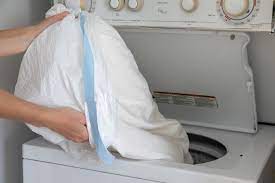Bed bugs are a common problem in households, and they can easily infest your washing machine. These tiny pests can survive in the machine for a long time, and if not cleaned properly, they can spread to other areas of your home. Therefore, it is important to know how to clean your washing machine after bed bugs infestation. In this article, we will discuss the steps you need to take to clean your washing machine effectively.
Step 1: Preparation
Before you start cleaning your washing machine, you need to prepare yourself and the machine. Wear gloves and a mask to protect yourself from any potential bed bugs. Remove all the clothes and other items from the machine and put them in a plastic bag. Seal the bag tightly and wash the clothes in hot water to kill any bed bugs that may be hiding in them.
Step 2: Vacuuming
The first step in cleaning your washing machine is to vacuum it thoroughly. Use a vacuum cleaner with a hose attachment to clean the inside of the machine, including the drum, the door seal, and the detergent dispenser. Pay special attention to the areas where bed bugs are likely to hide, such as the seams and crevices.
Step 3: Wiping Down
After vacuuming, use a damp cloth or sponge to wipe down the inside of the machine. Make sure you clean all the surfaces, including the drum, the door seal, and the detergent dispenser. Use hot water and a mild detergent to clean any stubborn stains or residue.
Step 4: Cleaning the Filter
The filter in your washing machine can also harbor bed bugs. Remove the filter and clean it thoroughly with hot water and a mild detergent. Use a toothbrush or a small brush to scrub away any dirt or debris that may be stuck to the filter.
Step 5: Cleaning the Dispenser Drawer
The dispenser drawer in your washing machine can also be a breeding ground for bed bugs. Remove the drawer and clean it thoroughly with hot water and a mild detergent. Use a toothbrush or a small brush to scrub away any dirt or debris that may be stuck to the drawer.
Step 6: Cleaning the Exterior
After cleaning the inside of the machine, it’s time to clean the exterior. Use a damp cloth or sponge to wipe down the outside of the machine, including the control panel and any other surfaces. Use hot water and a mild detergent to clean any stubborn stains or residue.
Step 7: Run a Hot Cycle
Once you have cleaned the machine, run a hot cycle with no clothes or detergent. This will help to kill any remaining bed bugs that may be hiding in the machine. Set the machine to the highest temperature possible and let it run for a full cycle.
Step 8: Dry the Machine
After running the hot cycle, leave the machine open to dry completely. This will help to prevent any moisture from building up inside the machine, which can attract bed bugs.
Step 9: Prevention
To prevent bed bugs from infesting your washing machine in the future, there are a few things you can do. First, always check your clothes and other items for bed bugs before putting them in the machine. Second, use a bed bug spray or powder to treat any infested areas in your home. Finally, vacuum your home regularly to remove any bed bugs that may be hiding in carpets, upholstery, or other areas.
Step 10: Regular Cleaning
Regular cleaning of your washing machine is important to prevent bed bugs from infesting it. Make sure you clean the machine at least once a month, and follow the steps outlined in this article to ensure that your machine is clean and free of bed bugs.
In conclusion, cleaning your washing machine after bed bugs infestation is crucial to prevent the spread of these pests to other areas of your home. By following the steps outlined in this article, you can effectively clean your washing machine and prevent bed bugs from infesting it in the future. Remember to wear gloves and a mask when cleaning, and always check your clothes and other items for bed bugs before putting them in the machine.

